Detailed graphic explanation of ajax cross-domain issues (with code)
This time I will bring you a detailed graphic explanation of ajax cross-domain issues (with code). What are the precautions for ajax cross-domain issues? . The following is a practical case, let's take a look.
Cross-domain
Same-origin policy restrictions
The same-origin policy prevents scripts loaded from one domain from obtaining or operating Document properties on another domain. That is, the domain of the requested URL must be the same as the domain of the current web page. This means that the browser isolates content from different sources to prevent operations between them.
Solution
Generally speaking, there are two common ways: one is from the server side, and the other is from the client's perspective. Set off. Both have advantages and disadvantages, and which method to use requires specific analysis.
Server sets response header
Server proxy
The client uses a script callback mechanism.
Method 1
The Access-Control-Allow-Origin keyword
will take effect only if it is set on the server side. In other words, even if you use
xmlhttprequest.setHeaderREquest('xx','xx');client, it will not have any effect.
Normal ajax request
Let’s simulate the case implementation of ajax non-cross-domain request.
test1.html
nbsp;html>
<meta>
<title>ajax 测试</title>
<input>
<p></p>
<script>
var xhr = new XMLHttpRequest();
var url = 'http://localhost/learn/ajax/test1.php';
function crossDomainRequest() {
document.getElementById('content').innerHTML = "<font color='red'>loading...";
// 延迟执行
setTimeout(function () {
if (xhr) {
xhr.open('GEt', url, true);
xhr.onreadystatechange = handle_response;
xhr.send(null);
} else {
document.getElementById('content').innerText = "不能创建XMLHttpRequest对象";
}
}, 3000);
}
function handle_response() {
var container = document.getElementById('content');
if (xhr.readyState == 4) {
if (xhr.status == 200 || xhr.status == 304) {
container.innerHTML = xhr.responseText;
} else {
container.innerText = '不能跨域请求';
}
}
}
</script>
The content of test1.PHP in the same directory is as follows:
<?php echo "It Works."; ?>
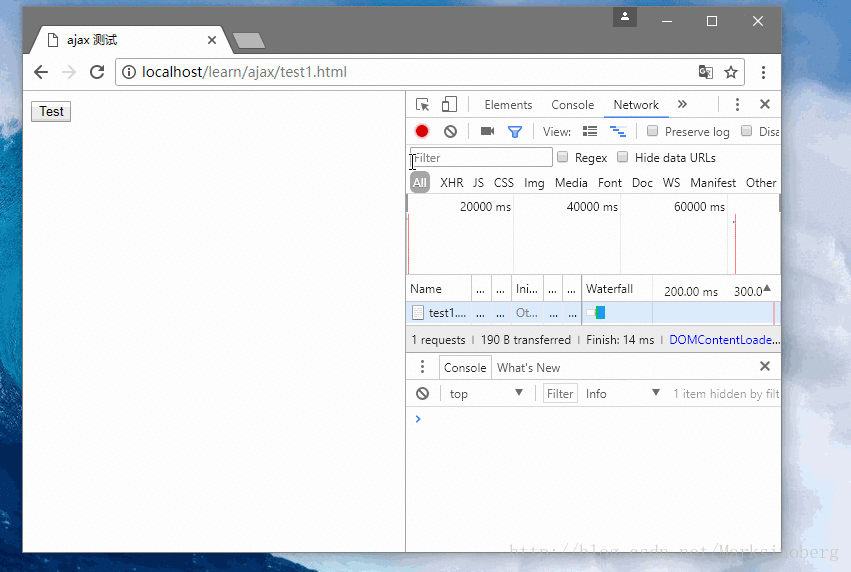
Cross-domain request
Just now, the HTML file and the PHP file were both under the Apache container, so there was no cross-domain situation. Now put the HTML file on the desktop and request the PHP data again, creating something like this A "cross-domain request".
Pay attention to the address bar information of the browser
When you visit again, you will find the following error message.
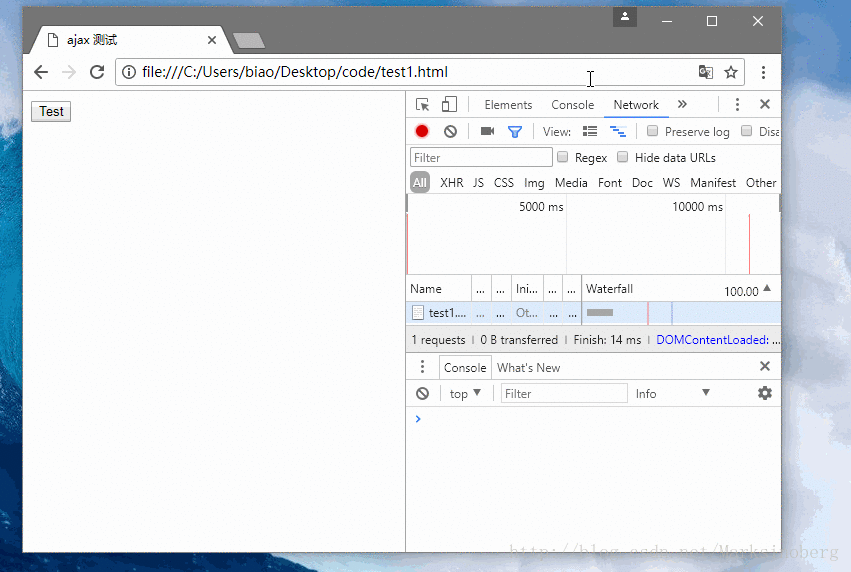
In this case, a common operation is to set Access-Control-Allow-Origin.
Format: Access-Control-Allow-Origin: domain.com/xx/yy.*
If you know the client’s domain name or the fixed path of the request, it is best not to use wildcards method to further ensure security. If you are not sure, just use the * wildcard character.
When the back-end development language is PHP, you can set it like this at the beginning of the file:
header("Access-Control-Allow-Origin: *");If it is an ASPX page, you need to set it like this (Java is similar):
Response.AddHeader("Access-Control-Allow-Origin", "*");At this time, visit the path just now again.
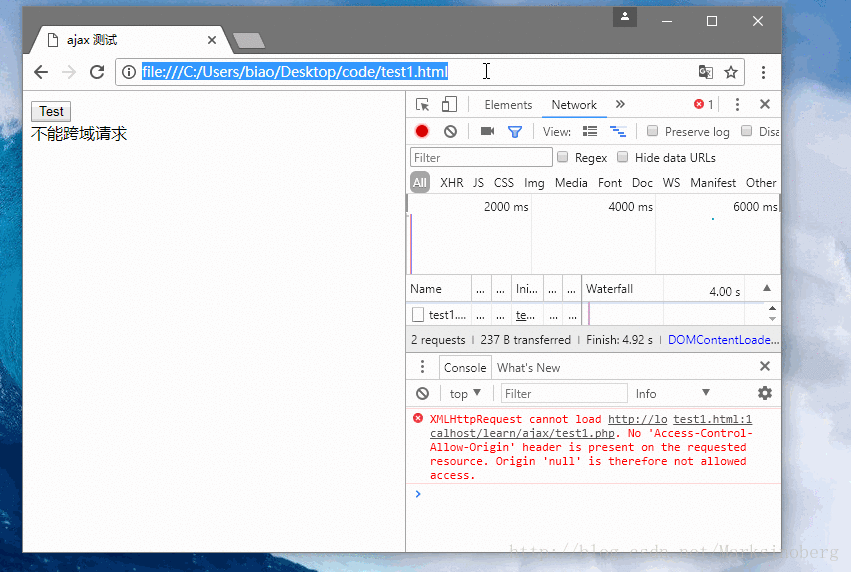
ServerAgent mode
This method should be considered more commonly used and widely adopted One way. To say that being an agent is a bit too written, but in fact, it is just a messenger. Let’s give a small example:
Xiao Ming likes a girl named Xiao Hong in Class 3, but is too embarrassed to ask for her QQ and WeChat ID. Then I asked Xiaolan, a girl from my class. Come and help yourself to get it. So Xiaolan is equivalent to an agent. Help Xiao Ming obtain Xiao Hong’s contact information that could not be obtained directly.
Let’s give an example to illustrate this problem.
Direct cross-domain request
Just modify the URL just now and let ajax directly request data from other websites.
nbsp;html>
<meta>
<title>ajax 测试</title>
<input>
<p></p>
<script>
var xhr = new XMLHttpRequest();
// var url = 'http://localhost/learn/ajax/test1.php';
var url = 'http://api.qingyunke.com/api.php?key=free&appid=0&msg=%E5%93%92%E5%93%92';
function crossDomainRequest() {
document.getElementById('content').innerHTML = "<font color='red'>loading...";
// 延迟执行
setTimeout(function () {
if (xhr) {
xhr.open('GEt', url, true);
xhr.onreadystatechange = handle_response;
xhr.send(null);
} else {
document.getElementById('content').innerText = "不能创建XMLHttpRequest对象";
}
}, 3000);
}
function handle_response() {
var container = document.getElementById('content');
if (xhr.readyState == 4) {
if (xhr.status == 200 || xhr.status == 304) {
container.innerHTML = xhr.responseText;
} else {
container.innerText = '不能跨域请求';
}
}
}
</script>
The results are as follows:
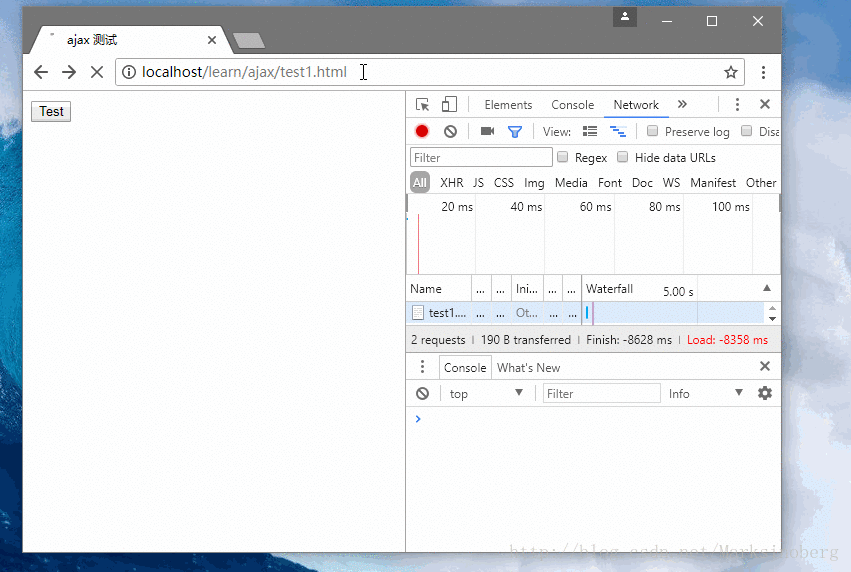
Enable proxy mode
For the HTML page just now, we still use our own Interface:
url = 'http://localhost/learn/ajax/test1.php';
The details are as follows:
nbsp;html>
<meta>
<title>ajax 测试</title>
<input>
<p></p>
<script>
var xhr = new XMLHttpRequest();
var url = 'http://localhost/learn/ajax/test1.php';
// var url = 'http://api.qingyunke.com/api.php?key=free&appid=0&msg=%E5%93%92%E5%93%92';
function crossDomainRequest() {
document.getElementById('content').innerHTML = "<font color='red'>loading...";
// 延迟执行
setTimeout(function () {
if (xhr) {
xhr.open('GEt', url, true);
xhr.onreadystatechange = handle_response;
xhr.send(null);
} else {
document.getElementById('content').innerText = "不能创建XMLHttpRequest对象";
}
}, 3000);
}
function handle_response() {
var container = document.getElementById('content');
if (xhr.readyState == 4) {
if (xhr.status == 200 || xhr.status == 304) {
container.innerHTML = xhr.responseText;
} else {
container.innerText = '不能跨域请求';
}
}
}
</script>
然后对应的test1.php应该帮助我们实现数据请求这个过程,把“小红的联系方式”要到手,并返回给“小明”。
<?php $url = 'http://api.qingyunke.com/api.php?key=free&appid=0&msg=hello%20world.'; $result = file_get_contents($url); echo $result; ?>
下面看下代码执行的结果。
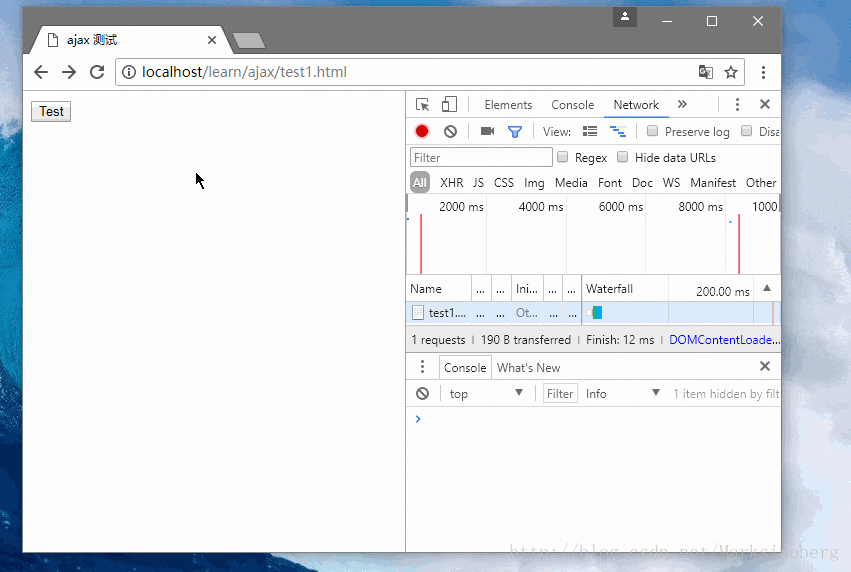
jsonp方式
JSONP(JSON with Padding) 灵感其实源于在HTML页面中script标签内容的加载,对于script的src属性对应的内容,浏览器总是会对其进行加载。于是:
克服该限制更理想方法是在 Web 页面中插入动态脚本元素,该页面源指向其他域中的服务 URL 并且在自身脚本中获取数据。脚本加载时它开始执行。该方法是可行的,因为同源策略不阻止动态脚本插入,并且将脚本看作是从提供 Web 页面的域上加载的。但如果该脚本尝试从另一个域上加载文档,就不会成功。
实现的思路就是:
在服务器端组装出客户端预置好的json数据,通过回调的方式传回给客户端。
原生实现
nbsp;html>
<meta>
<title>ajax 测试</title>
<script></script>
<input>
<input>
<p></p>
<script>
function jsonpcallback(result) {
for(var i in result) {
alert(i+":"+result[i]);
}
}
var JSONP = document.createElement("script");
JSONP.type='text/javascript';
JSONP.src='http://localhost/learn/ajax/test1.php?callback=jsonpcallback';
document.getElementsByTagName('head')[0].appendChild(JSONP);
</script>
服务器端test1.php内容如下:
<?php $arr = [1,2,3,4,5,6];
$result = json_encode($arr);
echo "jsonpcallback(".$result.")";
?>需要注意的是最后组装的返回值内容。
来看下最终的代码执行效果。
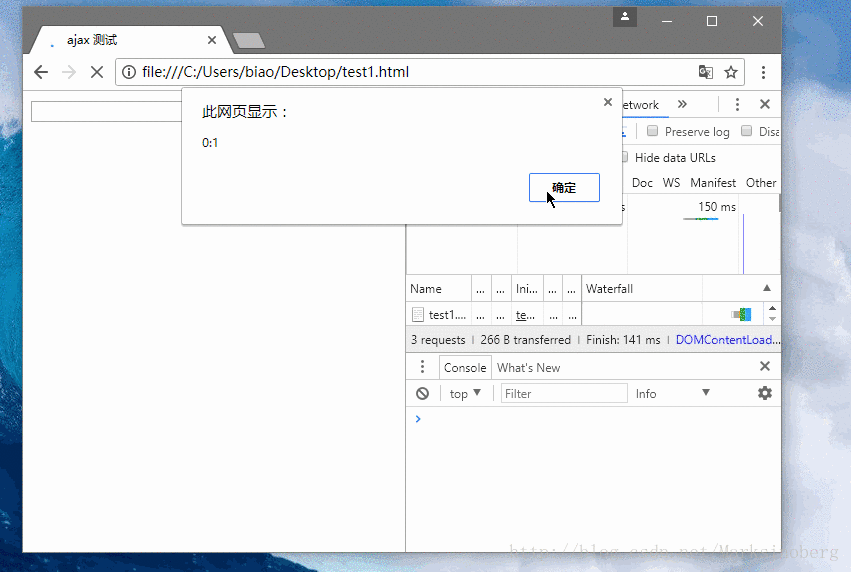
JQuery方式实现
采用原生的JavaScript需要处理的事情还是蛮多的,下面为了简化操作,决定采用jQuery来代替一下。
nbsp;html>
<meta>
<title>ajax 测试</title>
<script></script>
<input>
<input>
<p></p>
<script>
function later_action(msg) {
var element = $("<p><font color='green'>"+msg+"<br />");
$("#content").append(element);
}
$("#btn").click(function(){
// alert($("#talk").val());
$.ajax({
url: 'http://localhost/learn/ajax/test1.php',
method: 'post',
dataType: 'jsonp',
data: {"talk": $("#talk").val()},
jsonp: 'callback',
success: function(callback){
console.log(callback.content);
later_action(callback.content);
},
error: function(err){
console.log(JSON.stringify(err));
},
});
});
</script>
相应的,test1.php为了配合客户端聊天的需求,也稍微做了点改变。
<?php $requestparam = isset($_GET['callback'])?$_GET['callback']:'callback';
// 青云志聊天机器人接口: http://api.qingyunke.com/api.php?key=free&appid=0&msg=hello
// 接收来自客户端的请求内容
$talk = $_REQUEST['talk'];
$result = file_get_contents("http://api.qingyunke.com/api.php?key=free&appid=0&msg=$talk");
// 拼接一些字符串
echo $requestparam . "($result)";
?>最后来查看一下跨域的效果吧。
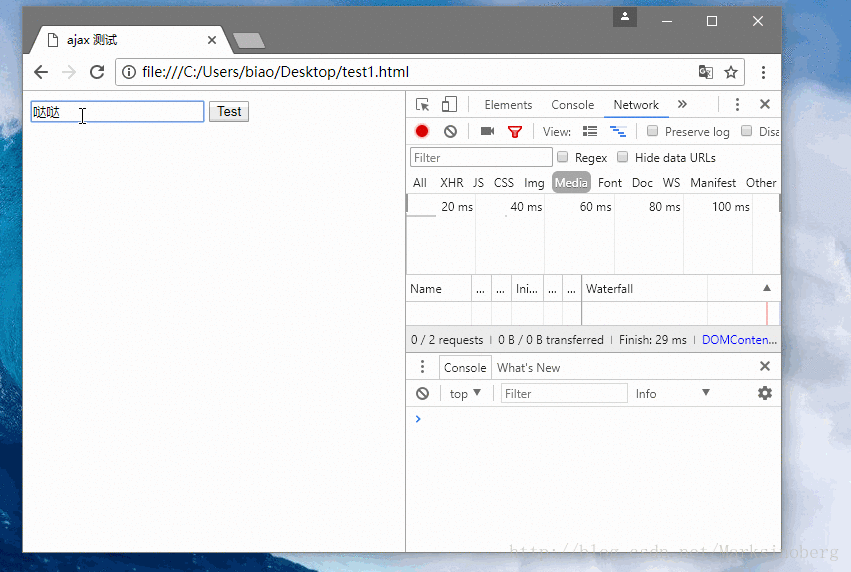
总结
至此,关于简单的ajax跨域问题,就算是解决的差不多了。对我个人而言,对于这三种方式有一点点自己的看法。
服务器设置Access-Control-Allow-Origin的方式适合信用度高的小型应用或者个人应用。
代理模式则比较适合大型应用的处理。但是需要一个统一的规范,这样管理和维护起来都会比较方便。
JSONP方式感觉还是比较鸡肋的(有可能是我经验还不足,没认识到这个方式的优点吧(⊙﹏⊙)b)。自己玩玩知道有这么个东西好了。维护起来实在是优点麻烦。
相信看了本文案例你已经掌握了方法,更多精彩请关注php中文网其它相关文章!
推荐阅读:
The above is the detailed content of Detailed graphic explanation of ajax cross-domain issues (with code). For more information, please follow other related articles on the PHP Chinese website!

Hot AI Tools

Undresser.AI Undress
AI-powered app for creating realistic nude photos

AI Clothes Remover
Online AI tool for removing clothes from photos.

Undress AI Tool
Undress images for free

Clothoff.io
AI clothes remover

Video Face Swap
Swap faces in any video effortlessly with our completely free AI face swap tool!

Hot Article

Hot Tools

Notepad++7.3.1
Easy-to-use and free code editor

SublimeText3 Chinese version
Chinese version, very easy to use

Zend Studio 13.0.1
Powerful PHP integrated development environment

Dreamweaver CS6
Visual web development tools

SublimeText3 Mac version
God-level code editing software (SublimeText3)

Hot Topics
 1655
1655
 14
14
 1414
1414
 52
52
 1307
1307
 25
25
 1253
1253
 29
29
 1227
1227
 24
24
 What to do if the blue screen code 0x0000001 occurs
Feb 23, 2024 am 08:09 AM
What to do if the blue screen code 0x0000001 occurs
Feb 23, 2024 am 08:09 AM
What to do with blue screen code 0x0000001? The blue screen error is a warning mechanism when there is a problem with the computer system or hardware. Code 0x0000001 usually indicates a hardware or driver failure. When users suddenly encounter a blue screen error while using their computer, they may feel panicked and at a loss. Fortunately, most blue screen errors can be troubleshooted and dealt with with a few simple steps. This article will introduce readers to some methods to solve the blue screen error code 0x0000001. First, when encountering a blue screen error, we can try to restart
 Detailed explanation of obtaining administrator rights in Win11
Mar 08, 2024 pm 03:06 PM
Detailed explanation of obtaining administrator rights in Win11
Mar 08, 2024 pm 03:06 PM
Windows operating system is one of the most popular operating systems in the world, and its new version Win11 has attracted much attention. In the Win11 system, obtaining administrator rights is an important operation. Administrator rights allow users to perform more operations and settings on the system. This article will introduce in detail how to obtain administrator permissions in Win11 system and how to effectively manage permissions. In the Win11 system, administrator rights are divided into two types: local administrator and domain administrator. A local administrator has full administrative rights to the local computer
 GE universal remote codes program on any device
Mar 02, 2024 pm 01:58 PM
GE universal remote codes program on any device
Mar 02, 2024 pm 01:58 PM
If you need to program any device remotely, this article will help you. We will share the top GE universal remote codes for programming any device. What is a GE remote control? GEUniversalRemote is a remote control that can be used to control multiple devices such as smart TVs, LG, Vizio, Sony, Blu-ray, DVD, DVR, Roku, AppleTV, streaming media players and more. GEUniversal remote controls come in various models with different features and functions. GEUniversalRemote can control up to four devices. Top Universal Remote Codes to Program on Any Device GE remotes come with a set of codes that allow them to work with different devices. you may
 PHP and Ajax: Building an autocomplete suggestion engine
Jun 02, 2024 pm 08:39 PM
PHP and Ajax: Building an autocomplete suggestion engine
Jun 02, 2024 pm 08:39 PM
Build an autocomplete suggestion engine using PHP and Ajax: Server-side script: handles Ajax requests and returns suggestions (autocomplete.php). Client script: Send Ajax request and display suggestions (autocomplete.js). Practical case: Include script in HTML page and specify search-input element identifier.
 How to use Copilot to generate code
Mar 23, 2024 am 10:41 AM
How to use Copilot to generate code
Mar 23, 2024 am 10:41 AM
As a programmer, I get excited about tools that simplify the coding experience. With the help of artificial intelligence tools, we can generate demo code and make necessary modifications as per the requirement. The newly introduced Copilot tool in Visual Studio Code allows us to create AI-generated code with natural language chat interactions. By explaining functionality, we can better understand the meaning of existing code. How to use Copilot to generate code? To get started, we first need to get the latest PowerPlatformTools extension. To achieve this, you need to go to the extension page, search for "PowerPlatformTool" and click the Install button
 Detailed explanation of division operation in Oracle SQL
Mar 10, 2024 am 09:51 AM
Detailed explanation of division operation in Oracle SQL
Mar 10, 2024 am 09:51 AM
Detailed explanation of division operation in OracleSQL In OracleSQL, division operation is a common and important mathematical operation, used to calculate the result of dividing two numbers. Division is often used in database queries, so understanding the division operation and its usage in OracleSQL is one of the essential skills for database developers. This article will discuss the relevant knowledge of division operations in OracleSQL in detail and provide specific code examples for readers' reference. 1. Division operation in OracleSQL
 How to solve the problem of jQuery AJAX error 403?
Feb 23, 2024 pm 04:27 PM
How to solve the problem of jQuery AJAX error 403?
Feb 23, 2024 pm 04:27 PM
How to solve the problem of jQueryAJAX error 403? When developing web applications, jQuery is often used to send asynchronous requests. However, sometimes you may encounter error code 403 when using jQueryAJAX, indicating that access is forbidden by the server. This is usually caused by server-side security settings, but there are ways to work around it. This article will introduce how to solve the problem of jQueryAJAX error 403 and provide specific code examples. 1. to make
 Detailed explanation of the linux system call system() function
Feb 22, 2024 pm 08:21 PM
Detailed explanation of the linux system call system() function
Feb 22, 2024 pm 08:21 PM
Detailed explanation of Linux system call system() function System call is a very important part of the Linux operating system. It provides a way to interact with the system kernel. Among them, the system() function is one of the commonly used system call functions. This article will introduce the use of the system() function in detail and provide corresponding code examples. Basic Concepts of System Calls System calls are a way for user programs to interact with the operating system kernel. User programs request the operating system by calling system call functions




